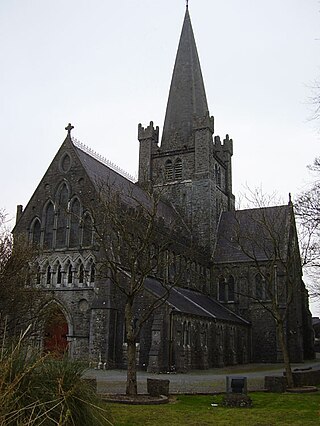
The Archbishop of Tuam is an archbishop which takes its name after the town of Tuam in County Galway, Ireland. The title was used by the Church of Ireland until 1839, and is still in use by the Catholic Church.
The Bishop of Clonfert is an episcopal title which takes its name after the village of Clonfert in County Galway, Ireland. In the Roman Catholic Church it remains as a separate title; but in the Church of Ireland it has been united with other bishoprics.
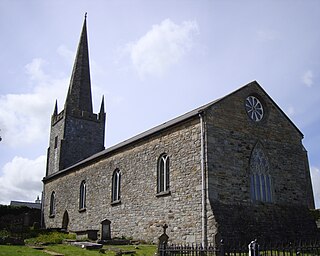
The Bishop of Killala is an episcopal title which takes its name after the village of Killala in County Mayo, Ireland. In the Roman Catholic Church it remains a separate title, but in the Church of Ireland it has been united with other bishoprics.
The Bishop of Achonry is an episcopal title which takes its name after the village of Achonry in County Sligo, Ireland. In the Roman Catholic Church it remains as a separate title, but in the Church of Ireland it has been united with other bishoprics.
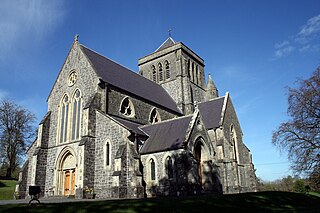
The Bishop of Kilmore is an episcopal title which takes its name after the parish of Kilmore, County Cavan in Ireland. In the Roman Catholic Church it remains a separate title, but in the Church of Ireland it has been united with other bishoprics.
The Bishop of Meath is an episcopal title which takes its name after the ancient Kingdom of Meath. In the Roman Catholic Church it remains as a separate title, but in the Church of Ireland it has been united with another bishopric.
The Bishop of Down and Connor is an episcopal title which takes its name from the town of Downpatrick and the village of Connor in Northern Ireland. The title is still used by the Catholic Church for the diocese of that name, but in the Church of Ireland it has been modified into other bishoprics.
The Bishop of Kilfenora was a separate episcopal title which took its name after the village of Kilfenora in County Clare in the Republic of Ireland. In both the Church of Ireland and the Roman Catholic Church, the title is now united with other bishoprics.
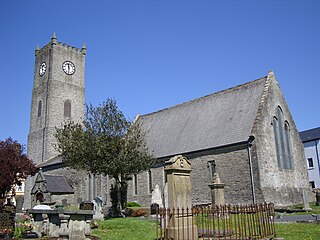
The Bishop of Raphoe is an episcopal title which takes its name after the town of Raphoe in County Donegal, Ireland. In the Roman Catholic Church it remains a separate title, but in the Church of Ireland it has been united with another bishopric.

The Bishop of Elphin is an episcopal title which takes its name after the village of Elphin, County Roscommon, Ireland. In the Roman Catholic Church it remains a separate title, but in the Church of Ireland it has been united with other bishoprics.
The Bishop of Clonfert and Kilmacduagh was the Ordinary of the Church of Ireland diocese of Clonfert and Kilmacduagh, comprising the southern part of County Galway and a small area of County Roscommon, Ireland. In 1834, Clonfert and Kilmacduagh became part of the united bishopric of Killaloe and Clonfert.
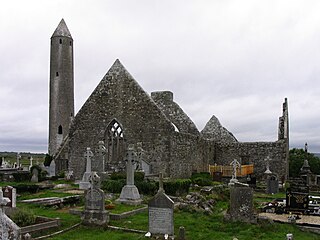
The Bishop of Kilmacduagh was an episcopal title which took its name after the village of Kilmacduagh in County Galway, Ireland. In both the Church of Ireland and the Roman Catholic Church, the title is now united with other bishoprics.
Christopher Bodkin was an Irish prelate, who was the Archbishop of Tuam, and Bishop of Kilmacduagh during the Irish Reformation.
James Blakedon O.P., D.Th. was a medieval prelate who served as Bishop of Achonry from 1442 to 1453, then Bishop of Bangor from 1453 to 1464.
Ambrose O'Madden was an Irish prelate of the Roman Catholic Church. He served as the Bishop of Clonfert from 1713 to 1715.
Robert Leslie was an Anglican prelate who served in the Church of Ireland as the Bishop of Dromore (1660–61), then Bishop of Raphoe (1661–71), and finally Bishop of Clogher (1671–72).

The Dean of Cashel is the head of the Chapter of the Cathedral Church of St John the Baptist and St Patrick's Rock, Cashel, one of the Church of Ireland cathedrals of the united Diocese of Cashel, Ferns and Ossory.

Henry Maxwell, D.D. (c.1723–1798) was an Anglican clergyman who served in the Church of Ireland as the Dean of Kilmore, then Bishop of Dromore, and finally Bishop of Meath.
William Bailie, D.D. was an Anglican clergyman who served in the Church of Ireland as Bishop of Clonfert and Kilmacduagh from 1644 to 1664.
Robert Howard, D.D. was an Anglican prelate who served in the Church of Ireland as the Bishop of Killala and Achonry (1727–1730) and Bishop of Elphin (1730–1740).








